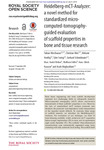| dc.contributor.author | Westhauser, Fabian | en_US |
| dc.contributor.author | Weis, Christian | en_US |
| dc.contributor.author | Hoellig, Melanie | en_US |
| dc.date.accessioned | 2016-10-11T05:37:14Z | |
| dc.date.available | 2016-10-11T05:37:14Z | |
| dc.date.issued | 2015 | en_US |
| dc.identifier.other | HPU4160666 | en_US |
| dc.identifier.uri | https://lib.hpu.edu.vn/handle/123456789/23556 | |
| dc.description.abstract | Bone tissue engineering and bone scaffold development represent two challenging fields in orthopaedic research. Micro-computed tomography (mCT) allows non-invasive measurement of these scaffolds’ propertiesin vivo. However, the lack of standardized mCT analysis protocols and, therefore, the protocols’ user-dependency make interpretation of the reported results difficult. To overcome these issues in scaffold research, we introduce the Heidelberg-mCT-Analyzer. | en_US |
| dc.format.extent | 15 p. | en_US |
| dc.format.mimetype | application/pdf | |
| dc.language.iso | en | en_US |
| dc.subject | Cellular and molecular biology | en_US |
| dc.subject | Computational | en_US |
| dc.subject | Physics | en_US |
| dc.subject | Bioengineering | en_US |
| dc.subject | Medical physics | en_US |
| dc.subject | Bone scaffold | en_US |
| dc.subject | Bone tissue engineering | en_US |
| dc.subject | Micro-computed tomography | en_US |
| dc.subject | Scaffold characterization | en_US |
| dc.title | Heidelberg-mCT-Analyzer | en_US |
| dc.type | Article | en_US |
| dc.size | 894KB | en_US |
| dc.department | Education | en_US |

